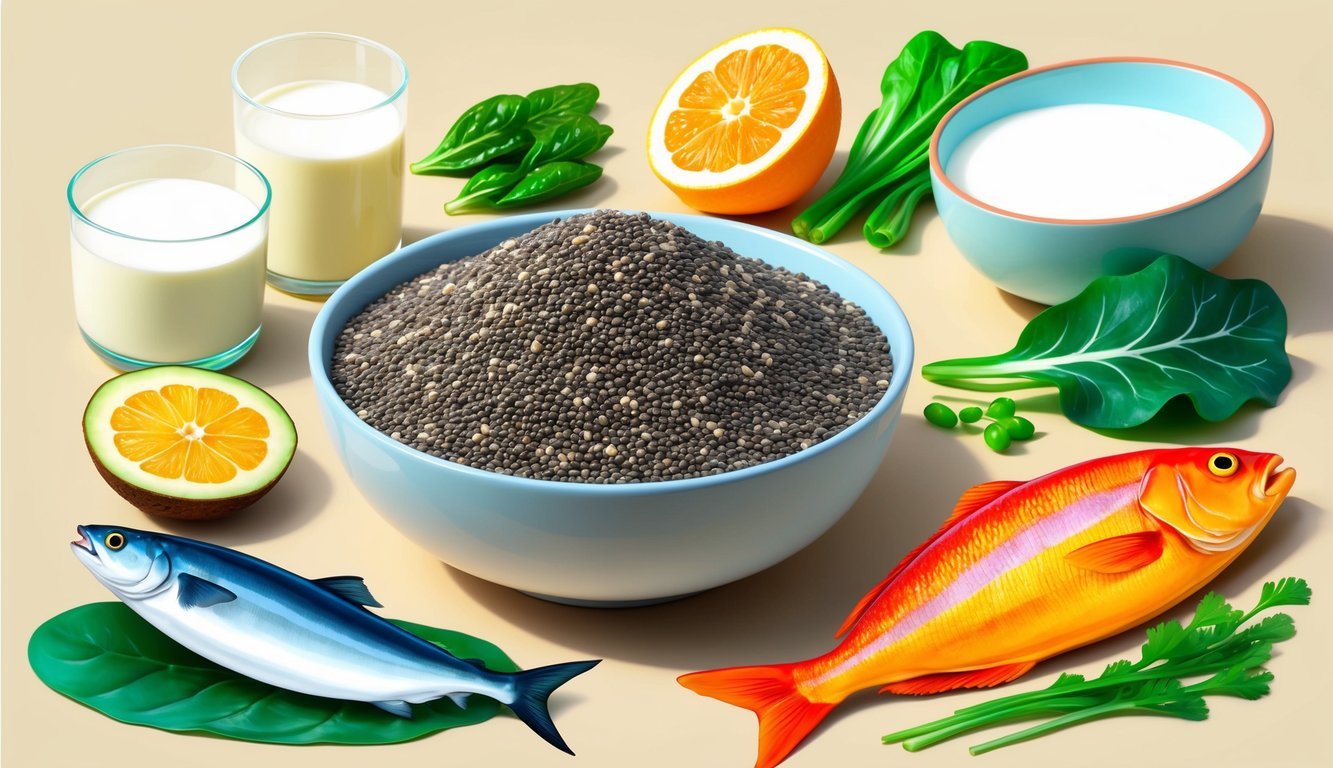I’ve come to realize how important it is to maintain healthy bones and joints as I go through life.
We often take them for granted until something goes wrong.
Taking proactive steps now can help ensure that my bones and joints stay strong and functional for years to come.

In this article, I’ll explore some practical tips that can make a real difference in bone and joint health.
Whether it’s through nutrition or exercise, small lifestyle changes can lead to significant benefits down the line.
Let’s dive into ways to keep moving freely and maintain our strength.
Eat more leafy greens
Incorporating more leafy greens into my diet has made a noticeable difference in my overall health.
These vegetables are packed with nutrients, especially calcium and vitamin K, which play crucial roles in maintaining bone strength.
I love adding spinach, kale, and Swiss chard to my meals.
They can easily be tossed into salads, smoothies, or even sautéed as a side dish.
The versatility of these greens makes it easy to enjoy them in various ways.
Regular consumption of leafy greens helps support bone density and may reduce the risk of osteoporosis.
It’s not only good for my bones but also beneficial for my joints.
Plus, the antioxidants found in these greens help combat inflammation, which is a win for joint health as well.
So whether I’m blending a smoothie or making a hearty salad, I always aim to include a generous serving of leafy greens.
It’s a simple and delicious way to support my bones and joints.
Incorporate salmon into meals
I love adding salmon to my meals for its health benefits.
It’s packed with vitamin D, which is essential for calcium absorption.
This makes it a great choice for maintaining strong bones.
Salmon is versatile, too.
I can grill, bake, or pan-sear it, and it pairs well with a variety of sides.
I often serve it with a salad or some roasted vegetables.
If I want something easy, I’ll toss some salmon on a salad.
It elevates a simple dish while boosting its nutritional content.
For breakfast, I sometimes mix it into scrambled eggs or have it in a breakfast burrito.
It adds flavor and nutrients right from the start of the day.
Don’t forget about using canned salmon as well.
It’s convenient and just as nutritious.
Plus, I can make quick salmon patties or sushi rolls with it.
Incorporating salmon into my meals is both delicious and beneficial for my bones.
It keeps my diet interesting while supporting my joint health.
3) Try yoga for flexibility
I’ve found yoga to be a great way to improve flexibility.
The gentle stretches help ease tension in my muscles and joints.
It feels good to move my body in these ways.
Starting with simple poses like the Cobra Pose and Triangle Pose works well for me.
These poses target different muscle groups, enhancing flexibility in my spine and legs.
I appreciate how they create a balanced stretch.
When I practice, I focus on my breathing.
This not only aids my stretches but also promotes a sense of calm.
The combination of movement and mindfulness is quite beneficial.
I’ve noticed that my range of motion improves gradually.
Regular sessions make everyday activities feel easier.
Overall, I feel more connected to my body and its capabilities.
Yoga is truly a practice I value for supporting my bone and joint health.
Take Vitamin D and Calcium Supplements

I’ve learned that vitamin D and calcium are crucial for maintaining strong bones.
They work together to enhance bone health.
Without enough calcium, my bones can become weak and more prone to fractures.
I make it a point to get enough of these nutrients, especially if my diet lacks sufficient amounts.
Calcium supplements can help meet daily requirements, particularly for adults.
For me, that means aiming for about 1,000 to 1,200 mg daily, depending on my age.
Vitamin D is equally important because it helps my body absorb calcium.
I try to get some sunshine to boost my vitamin D levels, but I also consider supplements, especially in winter.
This combination of vitamins not only supports my bone health but also helps reduce the risk of osteoporosis as I age.
Before I start any supplements, I always check with my healthcare provider.
They can guide me on the right amounts and ensure there are no interactions with other medications.
5) Drink fortified almond milk

I really enjoy drinking almond milk as a dairy alternative.
It’s a great choice if you’re lactose intolerant or just prefer plant-based options.
When I choose fortified almond milk, I make sure it includes calcium and vitamin D. These nutrients are crucial for bone health.
Calcium helps keep bones strong, while vitamin D improves calcium absorption.
Fortified almond milk typically offers about 30% of the daily value for calcium per serving.
This can be a delicious way to boost my intake, especially if I’m not consuming enough from other sources.
Additionally, almond milk is low in calories and contains healthy fats.
It has a light flavor that pairs well with smoothies or cereal.
Incorporating this drink into my diet is easy.
I use it in recipes or just pour it over my breakfast.
Overall, fortified almond milk is a simple and tasty option for supporting my bone health.
6) Enjoy bone broth

I love incorporating bone broth into my diet.
It’s not only delicious but also packed with nutrients that support joint and bone health.
Bone broth is made by simmering bones from meat, poultry, or fish for an extended period.
This process extracts collagen and other beneficial compounds.
I often stick to one type of bone, like chicken or beef, for the best flavor.
Drinking bone broth can help improve skin elasticity and provide essential amino acids.
These nutrients are crucial for maintaining strong bones and preventing damage over time.
I enjoy sipping it on its own or using it as a base for soups and stews.
Plus, making bone broth at home is simple and allows me to control the ingredients.
Whether I’m looking for a warm drink or a nutritious addition to my meals, bone broth always fits the bill.
7) Add chia seeds to your diet

I find chia seeds to be a simple and effective way to boost my bone health.
These tiny seeds pack a punch with their high calcium content, which is essential for strong bones.
Incorporating chia seeds into my meals is easy.
I like to mix them into smoothies or sprinkle them on yogurt.
They can also be added to oatmeal for an extra nutrient boost.
Chia seeds are rich in omega-3 fatty acids too.
This makes them a great addition for supporting overall joint health.
Plus, they’re high in fiber, which helps with digestion.
For a refreshing drink, I sometimes make chia water.
Soaking a couple of tablespoons of chia seeds in water for a few hours creates a gel-like texture, which is quite pleasant.
It’s a great way to stay hydrated while reaping the benefits.
Whether I use them in baking or as a simple topping, chia seeds are versatile and nutritious.
Adding them to my diet has become a fun and easy routine.
8) Practice weight-bearing exercises

I’ve found that weight-bearing exercises are essential for maintaining strong bones.
These activities require my body to work against gravity, which helps stimulate bone growth.
Exercises like walking, jogging, and resistance training can all contribute to improved bone density over time.
Incorporating these activities into your routine can help ensure you maintain healthy bones as you age.
Consistency is key, as regular movement strengthens both muscles and bones, reducing the risk of fractures.
Walking, jogging, and stair climbing are great options.
I enjoy brisk walking since it’s easy on my joints and can be done almost anywhere.
Strength training also plays a role.
I often use resistance bands or weights to build muscle.
Even simple exercises, like leg lifts, can make a difference.
The key is consistency.
I aim for at least 30 minutes of weight-bearing activities most days of the week.
This routine not only supports my bone health but also makes me feel more energized.
Incorporating these exercises into my lifestyle is manageable and rewarding.
9) Limit caffeine intake

I often enjoy my morning coffee, but I try to keep an eye on my caffeine intake.
Studies suggest that consuming less than 400 milligrams of caffeine daily is generally safe for most adults.
That’s about three to four cups of coffee.
Excessive caffeine can interfere with calcium absorption, which is crucial for bone health.
As I strive to maintain strong bones, I make it a point to limit my caffeine consumption.
Instead of coffee or energy drinks, I sometimes opt for herbal teas or decaffeinated beverages.
This way, I can still enjoy a warm drink without overdoing it on caffeine.
Additionally, I remind myself that staying hydrated is essential for overall bone function.
By cutting back on caffeine, I’m supporting my bones while still enjoying my favorite beverages in moderation.
10) Quit smoking

I’ve realized that quitting smoking can significantly benefit my bone and joint health.
Smoking is known to reduce bone density, making bones weaker over time.
When I stopped smoking, I noticed improvements in my energy levels and overall well-being.
The body begins to produce more antioxidants, which help combat damage associated with smoking.
Less bone density means a higher risk of fractures and joint problems.
By quitting, I’m not just helping my lungs, but I’m also giving my bones a chance to become stronger.
Maintaining healthy bones requires more than just exercise and diet.
It’s essential to consider the lifestyle choices I make.
Reducing harmful habits like smoking can pave the way for better joint health and resiliency.
Every little bit helps, and quitting smoking is a significant step toward feeling better physically.
It’s never too late to start making healthier choices for my bones and joints.
The Role of Diet in Bone and Joint Health
Diet plays a crucial role in maintaining strong bones and flexible joints.
Consuming the right nutrients can help support bone density and overall joint function.
This makes it vital to understand what to include in my meals.
Essential Nutrients for Bone Strength
Calcium is the standout nutrient for bone health.
I need to ensure I consume enough calcium daily.
For adults aged 19-50, the recommended intake is 1,000 mg.
This increases to 1,200 mg for women over 50 and men over 70.
Vitamin D is another essential player.
It helps my body absorb calcium effectively.
I can get vitamin D through sunlight or dietary sources like fatty fish, egg yolks, and fortified foods.
Other nutrients like magnesium, vitamin K, and phosphorus also contribute to bone strength.
Foods like green leafy vegetables, nuts, seeds, and dairy are excellent sources.
I strive to balance my meals with these nutrient-rich options to strengthen my bones.
Foods That Promote Joint Flexibility
For joint health, omega-3 fatty acids are my best friends.
Foods like fatty fish (salmon, mackerel), flaxseeds, and walnuts are packed with these beneficial fats.
Omega-3s can help reduce inflammation, which is vital for joint flexibility.
Antioxidants also play a significant role.
Colorful fruits and vegetables—like berries, cherries, and spinach—are rich in antioxidants that combat oxidative stress in the joints.
I also keep an eye on my lean protein intake, which is essential for repairing joint tissues.
Incorporating lean meats, legumes, and tofu into my diet can help maintain joint structure.
Staying mindful of these foods helps me keep my joints in good working order.
Importance of Regular Exercise
Keeping active is crucial for maintaining strong bones and healthy joints.
Regular exercise does more than just strengthen muscles; it plays a significant role in enhancing bone density and joint function.
Types of Exercises Beneficial for Bones
Weight-bearing and strength-training exercises are my go-to options for bone health.
Weight-bearing activities, like walking, jogging, and dancing, require my bones to work against gravity.
This helps stimulate bone formation and increases bone density.
Strength training, using free weights or resistance bands, also contributes to stronger bones.
It targets specific areas, promoting localized bone growth.
For instance, leg exercises like squats can improve bone strength in my legs and spine.
A balanced routine that includes these exercises helps lower the risk of fractures as I age.
Consistency is key, so I try to incorporate these activities into my weekly routine.
Exercises That Enhance Joint Function
To maintain flexibility and range of motion in my joints, I prioritize flexibility exercises like yoga, tai chi, and Pilates.
These activities are gentle on my joints, promoting movement without undue strain.
They help reduce stiffness and improve circulation, which is essential for joint health.
Active stretching allows my muscles to elongate and adapt, reducing the risk of injury.
Additionally, I focus on strengthening exercises that stabilize joints.
Building the surrounding muscle support can drastically improve joint stability.
By mixing these exercises into my weekly regimen, I ensure my joints stay healthy and function well.
Lifestyle Changes to Support Bone and Joint Health
Making mindful lifestyle changes can significantly enhance bone and joint health.
These changes primarily focus on reducing risk factors and integrating beneficial practices that support my overall well-being.
Reducing Risk Factors
To keep my bones and joints in top shape, I prioritize reducing risk factors.
One of the major risks is smoking, which I avoid due to its negative impact on bone density.
Excessive alcohol consumption is another concern, so I make sure to drink in moderation.
Maintaining a healthy weight also plays a crucial role.
Being overweight places extra stress on my joints, increasing the risk of conditions like osteoarthritis.
I focus on a balanced diet, emphasizing calcium and vitamin D, which are vital for bone health.
Foods I include in my meals are leafy greens, dairy products, and fatty fish.
Staying active is essential, but I listen to my body to avoid overdoing it.
I steer clear of high-impact activities that can strain my joints while opting for low-impact options like walking or swimming.
Incorporating Mind-Body Practices
Incorporating mind-body practices makes a real difference in how I feel.
Yoga and tai chi are fantastic for increasing flexibility and balance.
These activities not only strengthen my muscles but also enhance my range of motion.
This is crucial for joint health.
Meditation helps me manage stress, which can negatively affect my body in several ways, including inflammation.
I make time for mindfulness and relaxation techniques, which support my mental and physical health.
Lastly, I have found that getting enough sleep is non-negotiable.
Quality sleep allows my body to repair and regenerate, further supporting my bone and joint health.
Prioritizing these practices creates a holistic approach that I can sustain over time.

